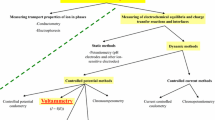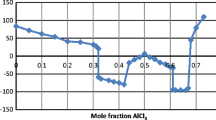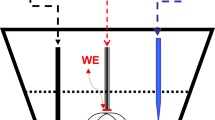Abstract
The electroneutrality approximation assumes that charge separation is impossible in electrolytic solutions. It has a long and successful history dating back to 1889 and may be justified because of the small absolute values for the permittivities of typical solvents. Dimensional analysis shows that the approximation becomes invalid only at nanosecond and nanometre scales. Recent work, however, has taken advantage of the capabilities of modern numerical simulation in order to relax this approximation, with concomitant advantages such as avoiding paradoxes and permitting a clear and consistent ‘physical picture’ to describe charge dynamics in solution. These new theoretical techniques have been applied to liquid junction potentials and weakly supported voltammetry, with strong experimental corroboration for the latter. So long as dynamic processes are being studied, for which analytical solutions are unavailable in any case, numerical simulation is shown to render electroneutrality unnecessary as an a priori assumption.







Similar content being viewed by others
Notes
The [sic] is used to indicate antiquated terminology while maintaining a faithful translation. “Free electricity” is taken to mean “free charge density” in a modern translation, but in the originals the word(s) “(freie) Elektrizität” are used consistently in place of “Ladung” or “Ladungsdichte”.
Author’s own translation from the original, pp 133–134. The p′ i refer to osmotic pressures of cations and the p′′ i refer to osmotic pressures of anions. We infer that by “fixed electricity”, Nernst means that ∑ i z i c i ≪ ∑ i |z i | c i .
Author’s own translation from the original, p 163.
References
Nernst W (1889) Die elektromotorische Wirksamkeit der Jonen. Z Phys Chem 4:129–181
Planck M (1890) Ueber die Erregung von Electricität und Wärme in Electrolyten. Wied Ann 39:161–186
Planck M (1890) Ueber die Potentialdifferenz zwischen zwei verdünnten Lösungen binärer Electrolyte. Wied Ann 40:561–576
Henderson P (1907) Zur Thermodynamik der Flüssigkeitsketten. Z Phys Chem 59:118–127
Guggenheim EA (1930) A study of cells with liquid-liquid junctions. J Am Chem Soc 52:1315–1337
Hickman HJ (1970) The liquid junction potential - the free diffusion junction. Chem Eng Sci 25:381–398
Jackson JL (1974) Charge neutrality in electrolytic solutions and the liquid junction potential. J Phys Chem 78:2060–2064
Perram JW, Stiles PJ (2006) On the nature of liquid junction and membrane potentials. Phys Chem Chem Phys 8:4200–4213
Dickinson EJF, Freitag L, Compton RG (2010) Dynamic theory of liquid junction potentials. J Phys Chem B 114:187–197
Ward KR, Dickinson EJF, Compton RG (2010) Dynamic theory of type 3 liquid junction potentials: formation of multilayer liquid junctions. J Phys Chem B 114:4521–4528
Ward KR, Dickinson EJF, Compton RG (2010) Dynamic theory of membrane potentials. J Phys Chem B 114:10763–10773
Bazant MZ, Thornton K, Ajdari A (2004) Diffuse-charge dynamics in electrochemical systems. Phys Rev E 70:021506
Bond AM, Fleischmann M, Robinson J (1984) Voltammetric measurements using microelectrodes in highly dilute solutions: theoretical considerations. J Electroanal Chem 172:11–25
Amatore C, Deakin MR, Wightman RM (1987) Electrochemical kinetics at microelectrodes. Part IV. Electrochemistry in media of low ionic strength. J Electroanal Chem 225:49–63
Amatore C, Fosset B, Bartelt J, Deakin MR, Wightman RM (1988) Electrochemical kinetics at microelectrodes. Part V. Migrational effects on steady or quasi-steady-state voltammograms. J Electroanal Chem 256:255–268
Oldham KB (1988) Theory of microelectrode voltammetry with little electrolyte. J Electroanal Chem 250:1–21
Norton JD, White HS, Feldberg SW (1990) Effect of the electrical double layer on voltammetry at microelectrodes. J Phys Chem 94:6772–6780
Cooper JB, Bond AM, Oldham KB (1992) Microelectrode studies without supporting electrolyte: model and experimental comparison for singly and multiply charged ions. J Electroanal Chem 331:877–895
Oldham KB (1992) Theory of steady-state voltammetry without supporting electrolyte. J Electroanal Chem 337:91–126
Myland JC, Oldham KB (1993) General theory of steady-state voltammetry. J Electroanal Chem 347:49–91
Ciszkowska M, Jaworski A, Osteryoung JG (1997) Voltammetric reduction of hydrogen ion in solutions of polyprotic strong acids with and without supporting electrolyte. J Electroanal Chem 423:95–101
Hyk W, Stojek Z (1997) Migrational chronoamperometry for various reaction stoichiometries and a variety of types of supporting electrolytes. J Electroanal Chem 439:81–88
Hyk W, Stojek Z (2002) Generalized theory of steady-state voltammetry without a supporting electrolyte. Effect of product and substrate diffusion coefficient diversity. Anal Chem 74:4805–4813
Hyk W, Stojek Z (2005) General theory for migrational voltammetry. Strong influence of diversity in redox species diffusivities on charge reversal electrode processes. Anal Chem 77:6481–6486
Bond AM, Feldberg SW (1998) Analysis of simulated reversible cyclic voltammetric responses for charged redox species in the absence of added electrolyte. J Phys Chem B 102:9966–9974
Stevens NPC, Rooney MB, Bond AM, Feldberg SW (2001) A comparison of simulated and experimental voltammograms obtained for the [Fe(CN)6]3 − /4 − couple in the absence of added supporting electrolyte at a rotating disk electrode. J Phys Chem A 105:9085–9093
Ciszkowska M, Stojek Z (2000) Voltammetric and amperometric detection without added electrolyte. Anal Chem 72:754A–760A
Bond AM (2004) Illustration of experimental and theoretical problems encountered in cyclic voltammetric studies of charged species without added supporting electrolyte. In: Pombeiro AJL, Amatore C (eds) Trends in molecular electrochemistry, chap 14. Marcel Dekker, New York, pp 445–502
Oldham KB, Bond AM (2001) How valid is the electroneutrality approximation in the theory of steady-state voltammetry? J Electroanal Chem 508:28–40
Smith CP, White HS (1993) Theory of the voltammetric response of electrodes of submicron dimensions violation of electroneutrality in the presence of excess supporting electrolyte. Anal Chem 65:3343–3353
Hyk W, Palys M, Stojek Z (1996) Migrational chronoamperometry of uncharged substrates. Influence of electron transfer rate. J Electroanal Chem 415:13–22
Bonnefont A, Argoul F, Bazant MZ (2001) Analysis of diffuse-layer effects on time-dependent interfacial kinetics. J Electroanal Chem 500:52–61
He R, Chen S, Yang F, Wu B (2006) Dynamic diffuse double-layer model for the electrochemistry of nanometer-sized electrodes. J Phys Chem B 110:3262–3270
Yang X, Zhang G (2007) Simulating the structure and effect of the electrical double layer at nanometer electrodes. Nanotechnology 18:335201/1–335201/9
Liu Y, He R, Zhang Q, Chen S (2010) Theory of electrochemistry for nanometer-sized disk electrodes. J Phys Chem C 114:10812–10822
Streeter I, Compton RG (2008) Numerical simulation of potential step chronoamperometry at low concentrations of supporting electrolyte. J Phys Chem C 112:13716–13728
Dickinson EJF, Compton RG (2010) The zero-field approximation for weakly supported voltammetry: a critical evaluation. Chem Phys Lett 497:178–183
Limon-Petersen JG, Streeter I, Rees NV, Compton RG (2008) Voltammetry in weakly supported media: the stripping of thallium from a hemispherical amalgam drop. Theory and experiment. J Phys Chem C 112:17175–17182
Limon-Petersen JG, Streeter I, Rees NV, Compton RG (2009) Quantitative voltammetry in weakly supported media: effects of the applied overpotential and supporting electrolyte concentration on the one electron oxidation of ferrocene in acetonitrile. J Phys Chem C 113:333–337
Dickinson EJF, Limon-Petersen JG, Rees NV, Compton RG (2009) How much supporting electrolyte is required to make a cyclic voltammetry experiment quantitatively ‘diffusional’? A theoretical and experimental investigation. J Phys Chem C 113:11157–11171
Limon-Petersen JG, Dickinson EJF, Rees NV, Compton RG (2009) Quantitative voltammetry in weakly supported media. Two electron transfer chronoamperometry of electrodeposition and stripping for cadmium at microhemispherical mercury electrodes. J Phys Chem C 113:15320–15325
Limon-Petersen JG, Han JT, Rees NV, Dickinson EJF, Streeter I, Compton RG (2010) Quantitative voltammetry in weakly supported media. Chronoamperometric studies on diverse one electron couples containing various charged species, dissecting diffusional and migrational contributions and assessing the breakdown of electroneutrality. J Phys Chem C 114:2227–2236
Limon-Petersen JG, Dickinson EJF, Doneux T, Rees NV, Compton RG (2010) Voltammetry involving amalgam formation and anodic stripping in weakly supported media: theory and experiment. J Phys Chem C 114:7120–7127
Belding SR, Limon-Petersen JG, Dickinson EJF, Compton RG (2010) Cyclic voltammetry in the absence of excess supporting electrolyte offers extra kinetic and mechanistic insights: comproportionation of anthraquinone and the anthraquinone dianion in acetonitrile. Angew Chem Int Ed 49:9242–9245
Limon-Petersen JG, Dickinson EJF, Belding SR, Rees NV, Compton RG (2010) Cyclic voltammetry in weakly supported media: the reduction of the cobaltocenium cation in acetonitrile - comparison between theory and experiment. J Electroanal Chem 650:135–142
Norton JD, Benson WW, White HS, Pendley BD, Abruña HD (1991) Voltammetric measurements of bimolecular electro-transfer rates in low ionic strength solutions. Anal Chem 63:1909–1914
Kowski M, Stojek Z, Palys MJ (2009) Significance of comproportionation reaction in multi-step electrochemical reduction of fullerene C60. Electrochem Commun 11:905–908
Acknowledgements
E.J.F.D. and J.G.L.P. thank St John’s College, Oxford and CONACYT, México, respectively, for funding support. E.J.F.D. additionally thanks Patrick Dickinson, Christopher Neumann, Benjamin Oestringer and Yvann Stephens for their assistance and advice concerning the translations from German.
Author information
Authors and Affiliations
Corresponding author
Additional information
For the special issue “Electrochemistry: Past, Present and Future”.
Rights and permissions
About this article
Cite this article
Dickinson, E.J.F., Limon-Petersen, J.G. & Compton, R.G. The electroneutrality approximation in electrochemistry. J Solid State Electrochem 15, 1335–1345 (2011). https://doi.org/10.1007/s10008-011-1323-x
Received:
Revised:
Accepted:
Published:
Issue Date:
DOI: https://doi.org/10.1007/s10008-011-1323-x




